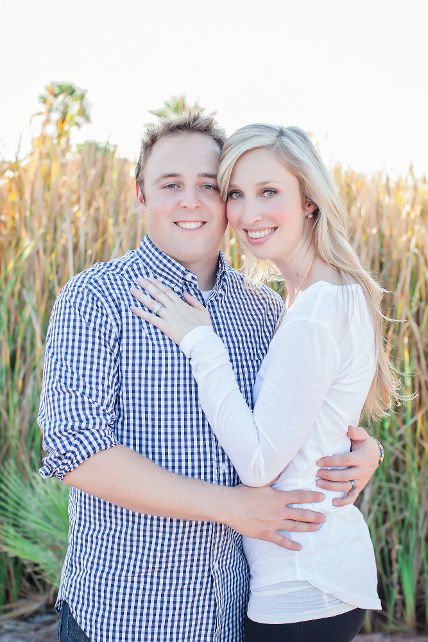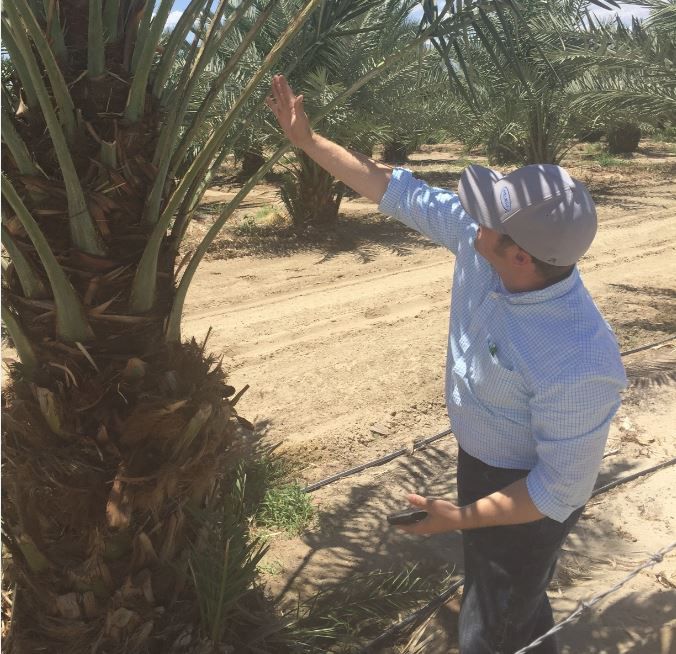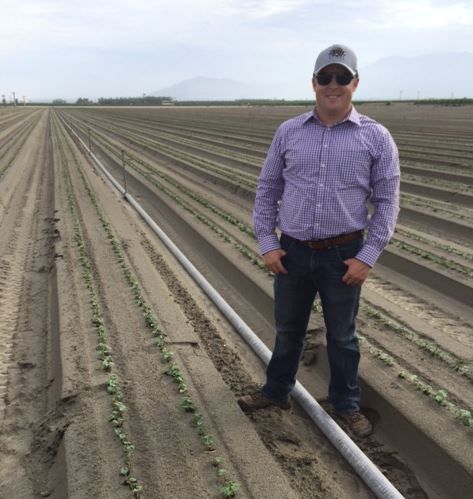Meet Arizona Agriculture’s Karl Wyant
Published
5/31/2016
By Julie Murphree, Arizona Farm Bureau Communication Director: This week we profile one of Arizona agriculture’s soil scientists, Karl Wyant. This transplanted Ph.D. inadvertently discovered he loved agriculture by
And, Wyant is keen on supporting an ever-advancing agriculture industry. “Agriculture is becoming increasingly data rich. Future agriculture scientists will have to do a better job of collecting, synthesizing, and presenting information from multiple data streams to different end users. For example, these data sets will need to be used by growers in order to optimize inputs, use water efficiently, organize harvest data (e.g., yield maps), and comply with
An ongoing series about Arizona agriculture’s farmers and ranchers.
Interview with Karl Wyant of Tempe, Arizona.
Tell us about your background and your work as a soil scientist with Helena? I have been working at Helena Chemical Company for about two years now as the Desert Agronomist. I cover a territory stretching from the Phoenix area, down to Marana, and then all the way out west to San Diego County with all the major desert agricultural areas in between (e.g., Yuma, Brawley, Blythe, Indio, San Jacinto, etc.).
I work to support, train, and empower our Pest Control Advisors (PCAs) in managing soil fertility and foliar inputs, water quality concerns, and crop performance issues by using a science
I also work with variable rate irrigation and fertilizer applications using a couple of specialized tools that let me measure

Karl and Sarah Wyant.
You’re from New Mexico and Michigan. Give us your family’s agriculture story: My grandparents grew up on farms in Western Michigan and have fond memories of making hay and harvesting sugar beets as kids. Like many folks in the area following WWII, they left the farm life to pursue jobs in the booming automotive sector in Detroit. As such, my parents did not grow up farming on either side and they later went into the education and healthcare fields. Fast forward a few years and you will find my parents
I am the first one to go back into the agricultural industry in my family since my grandparents were kids. I did not start my career path with agriculture in mind; I really just sort of fell into it when the opportunity came up and I have enjoyed every minute of it thus far.

Wyant discusses date palm diseases and nutrition with a grower. He covers a territory stretching from the Phoenix area, down to Marana, and then all the way out west to San Diego County with all the major desert agricultural areas in between (e.g., Yuma, Brawley, Blythe, Indio, San Jacinto, etc.).
How have you embraced Arizona and Arizona agriculture? I moved to Arizona in 2008 and bought a house in the ASU area soon thereafter. As a newcomer to the Phoenix area, I can tell you that the area is hard to figure out when you first arrive. Most cities show their history through their buildings and well-established neighborhoods (e.g., Denver, New York, Chicago, etc.). However, when you move to the Phoenix metroplex, it is hard to connect to the city in that fashion. It wasn’t until I started working in agriculture that I began to understand that the history of the metro area is firmly rooted in irrigated agriculture, both in the modern and historical sense. Now that I have been in the industry a bit, I now know the farm families that the streets and cities are named after and their historical connection to Arizona agriculture. I have a collection of old historical brochures that were produced by various Valley cities trying to get farmers to come out here to start up business. Some of these documents are as old as the 1880s and it gives you a great sense of the history of agriculture in Arizona. Furthermore, I really enjoy reading the ranch/farm family profiles that Arizona Farm Bureau publishes regularly.
What is your educational background (i.e. Degree(s), certifications, honors)? When I finished up high school in Gallup, I moved to Greeley, Colorado to attend the University of Northern Colorado where I majored in biology (pre-med) and minored in both chemistry and psychology. I was convinced that medical school was the route in life I wanted to take, however, I had the opportunity to get into the soil science research field as a lab tech. As an undergrad research tech, I got to travel all over Colorado, Wyoming and South Dakota-area collecting and analyzing soil samples. I was able to do work in the high Rocky Mountain elk habitat, crawl through cave systems in South Dakota, and do some cool experiments on the rangelands of northern Colorado. It was here that I discovered that med school wasn’t for me and that I was meant to be a soil scientist.

Loving his role in agriculture, Wyant says, "The agricultural industry represents a tiny fraction of the total population yet has far reaching effects on national food security, foreign policy issues, domestic water use issues, and the overall quality of life that we all enjoy."
Following graduation, I was accepted into the Ecology Department at Colorado State University, for
After freezing my hands off (permafrost soils are cold!), I decided to get my Ph.D. in a much warmer place but just as extreme as Arctic tundra. I was accepted into the Biology program at Arizona State University (Go Sun Devils!) where I focused my dissertation and coursework efforts on understanding the biotic properties and network behavior of arid soil systems and associated rates of nitrogen mineralization. Here I worked along the San Pedro River near Sierra Vista and at Fort Huachuca in southeast Arizona. I also did some urban work looking at how landscape type (e.g., grass lawn, xeriscape, etc.) can translate into
When I wrapped up my
Will anyone in your family – younger generation – pursue farming, ranching, or agribusiness? It’s hard to say at this point where the younger kids in my family will end up. However, I do have two nephews that live in Maricopa that
I don’t have kids yet but chances are they will be exposed to agriculture early on by way of what I do.
What are your community activities? I am a member of the Arizona Cactus and Succulent Society and the Orchid Society of Arizona.
What do you love the most about the agriculture industry in general? I love the hard work and the people that commit themselves every day to producing high-quality food and fiber for the local, national, and global markets. Personally, it is quite gratifying to see my efforts and training as a scientist translate into the success of our growers. I enjoy the hands on aspect of the job and the opportunities that come along every day to learn something new.
What do you enjoy doing, and what is one fact/achievement that nobody knows about you? I am a certified Master Gardener through the U. of A. Cooperative Extension Program in Maricopa County. Here I volunteer my time in the demonstration garden, help answer questions, and help spread the word about how easy it is to grow crops in our fantastic climate. I also collect plants and I now focus my collection efforts on the Aloe, Agave, and Echinocereus genera. I also have a pet tarantula named Chewbacca that my wife is scared of.
Why are you a Farm Bureau member? The agricultural industry represents a tiny fraction of the total population yet has far reaching effects on national food security, foreign policy issues, domestic water use issues, and the overall quality of life that we all enjoy. Thus, we require a dedicated voice to ensure that our interests and issues are properly heard, at all political levels, and not drowned out by more boisterous special interests groups.
How will the next generation of agriculturalists have to operate? Agriculture is becoming increasingly data rich. Future agriculture scientists will have to do a better job of collecting, synthesizing, and presenting information from multiple data streams to different end users. For example, these data sets will need to be used by growers in order to optimize inputs, use water efficiently, organize harvest data (e.g., yield maps), and comply with increased regulation.
What is the best business advice that you’ve received and/or have given? Or, what business-oriented advice would you give young farmers/beginning farmers? The best advice I have been given comes from the successful and experienced PCAs at Helena Chemical Company. Their advice is to simply listen. Just stop talking and start listening. People reveal what they need from you, what types of issues they are having on their field, or what their production goals are in the conversations you have with them. If you can master listening, you can quickly figure out where your talents might best fit to solve a problem. I know, it is super simple advice, but it really works!
From your perspective as a soil scientist, what’s the next big thing? I mentioned above that data management is a large issue looming on the horizon. We increasingly need to document and make decisions using a variety of data sets, especially when it comes to soil fertility planning and water quality management.
Another big thing is that the agriculture industry needs to get better about recruiting the next generation of skilled workers into the fold. I recently read a report that 22.5k agriculture jobs went unfulfilled in 2015 (http://www.agweb.com/article/want-a-job-major-in-agriculture-naa-alison-rice/) due to a shortage of students with proper training. This probably reflects a broader disconnect between an urbanized America and those that grow the food. With this shortage in mind, I think the industry needs to figure out a way to pull in and train talented people that might necessarily not have a personal background in agriculture but have the necessary analytical and science training needed to be successful. Modern agriculture is a high-tech endeavor and we need students with the passion and training to make it all work.